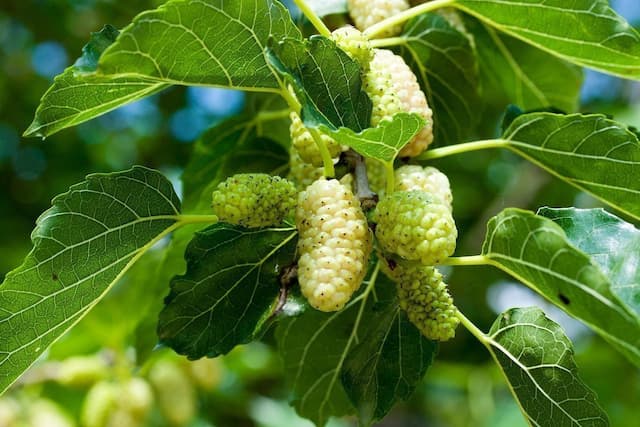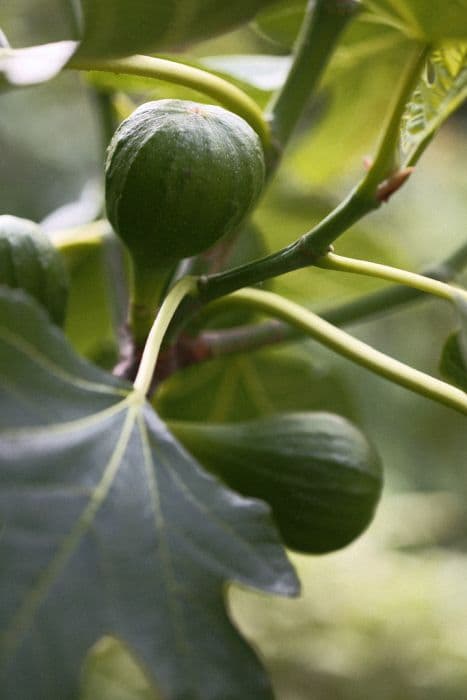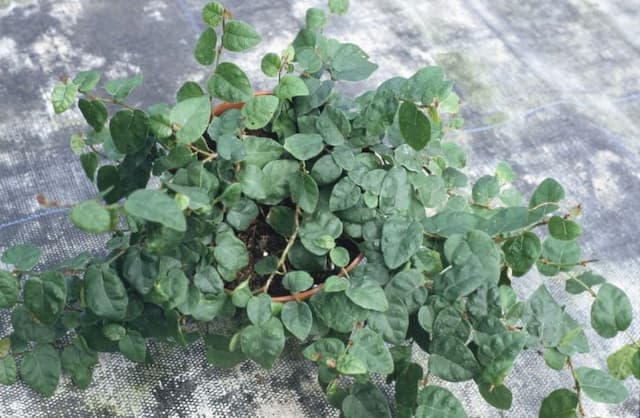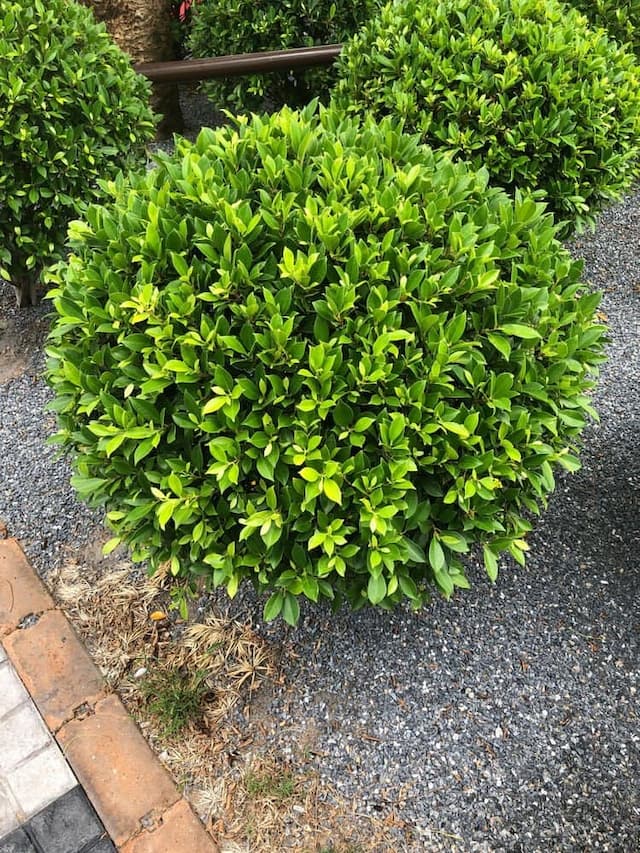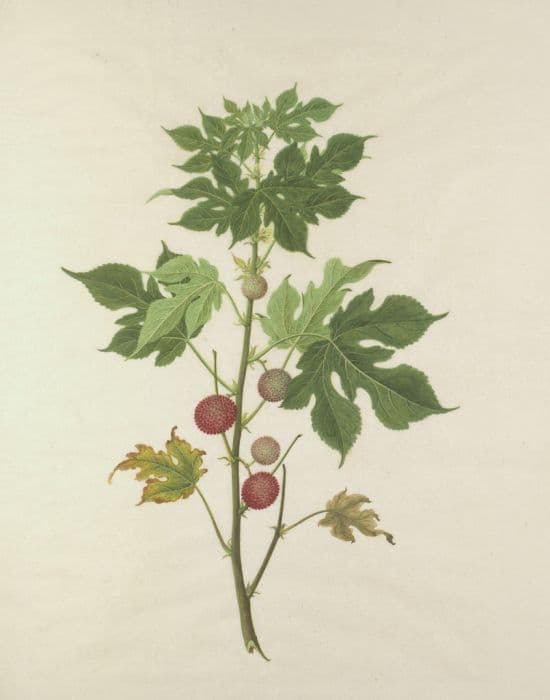Indian Laurel Ficus microcarpa 'Hawaii' (v)

ABOUT
The Ficus microcarpa 'Hawaii', commonly known as the Indian Laurel, is a variety of fig tree with a lush and appealing appearance. It is characterized by a dense canopy of glossy green leaves that are small and oval-shaped, often with a slightly pointed tip. The foliage tends to have a leathery texture, making it quite robust and hearty. Branching is typically plentiful, giving the plant a full look. The bark of the Indian Laurel has a smooth texture and can appear in shades of gray or light brown. Occasionally, tiny inedible fruits may manifest, which are not significant for ornamental purposes. The intricate root system of this plant is often visible above the soil surface, adding an interesting visual aspect to its structure. Overall, the Indian Laurel presents an elegant shape and can serve as an attractive feature in various landscapes or as an indoor ornamental tree.
About this plant
 Names
NamesFamily
Moraceae
Synonyms
Indian Laurel, Curtain Fig, Chinese Banyan, Malayan Banyan, Gajumaru
Common names
Ficus microcarpa, Ficus microcarpa var. crassifolia, Ficus microcarpa var. latifolia, Ficus microcarpa var. microcarpa, Ficus retusa, Ficus retusa var. nitida, Ficus retusa var. microcarpa, Ficus taiwanensis.
 Toxicity
ToxicityTo humans
The Ficus microcarpa, commonly known as the Indian Laurel, is not highly toxic to humans. However, it does contain irritating sap that can cause skin irritation or allergic reactions in sensitive individuals. If the plant parts or its sap are ingested, it may cause mild gastrointestinal discomfort or irritation of the mouth and throat. The most common symptoms after ingestion include oral irritation, vomiting, and diarrhea. In most cases, symptoms are self-limiting and do not require medical treatment beyond symptomatic care and ingestion of fluids. Nevertheless, it is always advisable to keep houseplants out of the reach of children who may chew on their leaves or stems.
To pets
The Indian Laurel, also known as the Ficus microcarpa, is considered toxic to pets such as dogs and cats. The primary toxic agents are the ficin and furocoumarins found in the sap. If pets chew or ingest parts of the plant, they can experience irritation of the mouth and gastrointestinal tract, which may result in symptoms like drooling, vomiting, and diarrhea. Moreover, skin contact with the sap can cause dermatitis in some pets. If you suspect your pet has ingested parts of the Ficus microcarpa, it is best to consult a veterinarian. In most cases, treatment is supportive, focusing on the alleviation of the symptoms, but close monitoring by a veterinary professional is essential to ensure the well-being of the pet.
 Characteristics
CharacteristicsLife cycle
Perennials
Foliage type
Evergreen
Color of leaves
Green
Height
50 feet (15 meters)
Spread
50 feet (15 meters)
Plant type
Tree
Hardiness zones
9
Native area
Asia
Benefits
 General Benefits
General Benefits- Low Maintenance: The Ficus microcarpa 'Hawaii', also known as Indian Laurel, is relatively easy to care for and does not require frequent watering or pruning.
- Durable: It is a sturdy plant that can withstand less-than-ideal conditions like low light and drought periods better than many other indoor plants.
- Aesthetic Appeal: With its dense, glossy green foliage, Indian Laurel is often used in landscaping and interior design for its lush and attractive appearance.
- Long Lifespan: When given the proper care, this plant can live for many years, offering long-term greenery for both indoor and outdoor settings.
- Erosion Control: Indian Laurel can be planted outdoors to help stabilize soil and prevent erosion with its rooting system.
- Sound Barrier: This plant, when grown as a hedge, can act as a natural sound barrier, reducing noise pollution.
- Shade Provider: Large Indian Laurel trees offer shade in gardens or patios, creating a cooler environment during hot weather.
- Windbreak: It can serve as a windbreak when planted in rows or as part of a hedge, protecting the area from strong winds.
- Privacy Screen: Due to its dense foliage, Indian Laurel is commonly used to create a natural privacy screen for homes or gardens.
- Supports Biodiversity: The tree can host a variety of wildlife, including birds and beneficial insects, contributing to ecological balance.
 Medical Properties
Medical PropertiesThis plant is not used for medical purposes.
 Air-purifying Qualities
Air-purifying QualitiesThis plant is not specifically known for air purifying qualities.
 Other Uses
Other Uses- Ficus microcarpa 'Hawaii' can be used in bonsai culture, where artists meticulously prune and shape the plant over many years to create a miniature tree that mimics the shape of a full-size tree.
- The robust roots of Ficus microcarpa 'Hawaii' can be trained over rock formations, to create stunning natural art pieces for gardens or public parks, known as root-over-rock displays.
- Due to its dense foliage, Ficus microcarpa 'Hawaii' can be employed as a privacy screen in residential landscapes or patios to create a natural barrier from neighbors or passersby.
- Ficus microcarpa 'Hawaii' branches are sometimes used in floral arrangements or as part of decorative table centerpieces, especially for tropical-themed events.
- The thick canopy of Ficus microcarpa 'Hawaii' offers shade in hot climates, making it ideal for planting in urban areas where it can help reduce the heat island effect.
- The sturdy and expansive canopy makes Ficus microcarpa 'Hawaii' a good host for growing orchids and ferns as epiphytes, allowing gardeners to create a layered plant display.
- Ficus microcarpa 'Hawaii' wood, being quite sturdy, can be repurposed by woodworkers to craft household items like picture frames or small decorative objects.
- The trunk of Ficus microcarpa 'Hawaii' can be manipulated to grow into living structures, such as arbors or tunnels, in imaginative garden designs.
- Leaves of the Ficus microcarpa 'Hawaii' can be used for crafting green, natural dyes for textiles, although this is less common and may require experimentation for colorfastness.
- The fallen leaves of Ficus microcarpa 'Hawaii' can be collected and composted, providing a nutrient-rich addition to soil for gardeners and reducing organic waste.
Interesting Facts
 Feng Shui
Feng ShuiThe Indian Laurel is believed to bring positive energy and improve air quality, enhancing the energy of the surrounding space. In Feng Shui, it can be placed in the wealth corner of a home or office to attract prosperity, or in the living room to promote a sense of wellbeing and balance.
 Zodiac Sign Compitability
Zodiac Sign CompitabilityThe Indian Laurel is not used in astrology practice.
 Plant Symbolism
Plant Symbolism- Endurance and Resilience: The Ficus microcarpa, commonly known as the Chinese Banyan, can thrive in difficult environments and thus symbolizes the ability to withstand challenging conditions.
- Growth and Stability: As a tree with strong roots, it represents personal growth and stability in life, encouraging one to stay grounded.
- Peace and Harmony: With its lush foliage, the Chinese Banyan is often associated with bringing peace and harmony into one's surroundings, making it a popular choice for bonsai or home plants.
- Longevity: The species is known for its long lifespan, which allows it to symbolize long-lasting life or relationships.
- Prosperity: In some cultures, the Ficus microcarpa is considered to be a bringer of prosperity and good fortune to its owner.
 Water
WaterFor the Chinese Banyan, water when the top inch of soil feels dry, which typically equates to once a week, depending on the environmental conditions such as temperature and humidity. Use room-temperature water and pour it evenly around the base of the plant, avoiding water on the leaves to prevent fungal diseases. Each watering should be thorough, allowing a small amount of water to run out of the drainage holes, indicating the soil is fully saturated, which may be around half a gallon for a medium-sized plant, depending on the size of the pot and the plant. During the winter months, reduce watering as the plant's growth slows down. Monitor the soil moisture regularly since overwatering can lead to root rot.
 Light
LightChinese Banyan thrives in bright, indirect light but can also adapt to medium light conditions. Place the plant where it can receive plenty of light without direct sun exposure that can scorch the leaves, such as near an east- or west-facing window with sheer curtains for light diffusion. Avoid low-light areas, as insufficient light can stunt growth and lead to leaf loss.
 Temperature
TemperatureThe Chinese Banyan prefers a temperature range between 60°F and 75°F but can tolerate a range from 55°F to 85°F. Avoid placing the plant in locations with cold drafts or sudden temperature changes. The ideal conditions would keep the plant consistently within its preferred temperature range to promote healthy growth.
 Pruning
PruningPruning the Chinese Banyan is important to maintain its shape and encourage bushier growth. Prune in the late winter or early spring before new growth begins, removing dead or crowded branches to improve light and airflow. Additionally, you can trim back leggy growth to keep the plant compact. Do this lightly throughout the growing season, but the main pruning should be once a year.
 Cleaning
CleaningAs needed
 Soil
SoilThe best soil mix for the Chinese Banyan should be well-draining and rich in organic matter. A mixture of two parts peat, one part pine bark, and one part coarse sand or perlite is ideal. The soil pH should be slightly acidic to neutral, ranging from 6.0 to 7.5.
 Repotting
RepottingThe Chinese Banyan should be repotted every two to three years to replenish the soil and allow room for growth. Younger plants may require more frequent repotting, while mature specimens can be repotted less often.
 Humidity & Misting
Humidity & MistingThe Chinese Banyan thrives in moderate to high humidity levels, ideally between 40-70%. A humidifier or regular misting can help maintain these conditions indoors.
 Suitable locations
Suitable locationsIndoor
Place in bright, indirect light and enjoy.
Outdoor
Provide moderate shade, protect from cold winds.
Hardiness zone
9-11 USDA
 Life cycle
Life cycleThe Chinese Banyan (Ficus microcarpa 'Hawaii') begins its life cycle as a seed, which upon germination, develops into a small seedling. As the seedling grows, it forms a juvenile plant characterized by rapid growth and the development of its distinctive foliage. Over time, the plant transitions into a mature phase, marked by a thickened trunk and the development of aerial roots, assuming growth conditions are adequate for this species. The Chinese Banyan will then flower and produce small fruits called figs that, when pollinated, usually by specific wasps, contain seeds for the next generation of plants. After pollination and fruiting, the cycle repeats. This plant can live for many years, becoming increasingly expansive and tree-like, with a large canopy and robust root system.
 Propogation
PropogationPropogation time
Spring-Early Summer
The Ficus microcarpa 'Hawaii', commonly known as the Indian Laurel or Hawaiian Ficus, is most commonly propagated through stem cuttings. The cuttings are taken from healthy, mature plants during the warmer months, generally spring through early summer, when the plant is actively growing. A cutting, typically 4 to 6 inches long (about 10 to 15 centimeters), is snipped just below a node, where leaves attach to the stem, as this area contains high concentrations of growth cells. The lower leaves of the cutting are removed, and the cut end is often treated with rooting hormone to encourage root development. The cutting is then placed in a well-draining potting mix and kept in a warm, humid environment with indirect sunlight until roots have developed, which generally takes about 4 to 8 weeks. During this time, the soil should be kept moist but not soggy to support root growth without causing rot.


